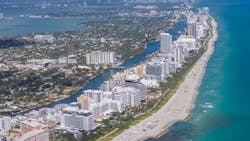Sea level rise has been a recurring topic in Clark’s Remarks, but coastline erosion has not been specifically addressed. Until today.
Here in South Florida, including Broward County where I live, we try to prevent tidal flooding and coastline erosion through the use of tidal flood barriers such as banks, berms, green-grey infrastructure (a combination of engineered and natural features), upland stem walls and, of course, seawalls. Virtually every property – private and public – on the beach, the Intracoastal Waterway, or on one of the 18 canals just in Broward County has a seawall.
In 2010, before climate change was widely discussed in the mainstream media, four southern counties formed the Southeast Florida Regional Climate Change Compact. One of the Compact’s early goals was to develop a uniform plan and strategy for seawalls.
While seawalls are critical to preventing tidal flooding, they are themselves vulnerable to water intrusion and have limited life spans. Many are 40 or 50 years old and, absent a uniform code or standard, were not properly constructed or installed when new.
South Florida soils are mostly limestone, not bedrock, so seawalls are always at risk of failing over time. Extreme high tides, which occur 6-8 times per year, can breach the seawalls, which can cause them to collapse and, because there is no water pressure during extreme low tides to help anchor them, those low tides can also collapse them.
In any case, although seawalls are not as friendly to the coastal ecology as are natural shorelines such as littoral zones (the shallow water close to shore, hosting aquatic plants and animals), they are for now a necessary evil.
In an effort to improve coastal protection without the use of costly and unreliable structures, a Northwestern University researcher, Prof. Rotta Loria (who works at the intersection of the fields of Mechanics of Materials, Energy, and Electrochemistry), has found an innovative way to strengthen the seabed beneath sea walls.
His process can also stabilize sand to prevent beach erosion, eliminating the need for sand replenishment, where lost sand lost is replaced from another source. The downside to beach replenishment is, of course, the fact that it’s only a temporary solution, since the added sand may well disappear with the next storm.
Prof. Loria calls the process, recently published in Communications Earth & Environment, “Electrodeposition of calcareous cement from seawater in marine silica sands.” That's a long name for applying mild electrical stimulations to the seawater to precipitate its solid mineral binders – primarily magnesium hydroxide and calcium carbonate – thus “cementing” the sand without the use of cement.
This process mimics the manner in which marine organisms use metabolic energy to grow their shells from the minerals in seawater. Since the electric charge is very low, it poses no threat to marine life or beachgoers, and the resulting sand is as strong as a seawall. That could be really good news for the United Nations’ estimate that 40% of the world’s population lives within 100 kilometers (62 miles) of a coast.
##########
